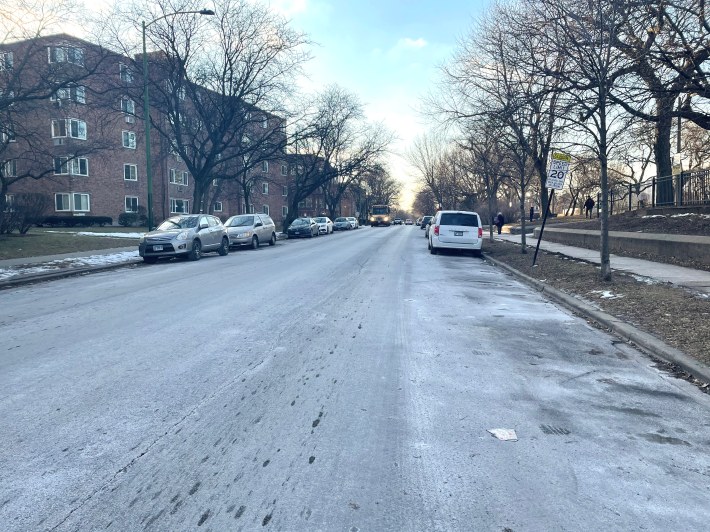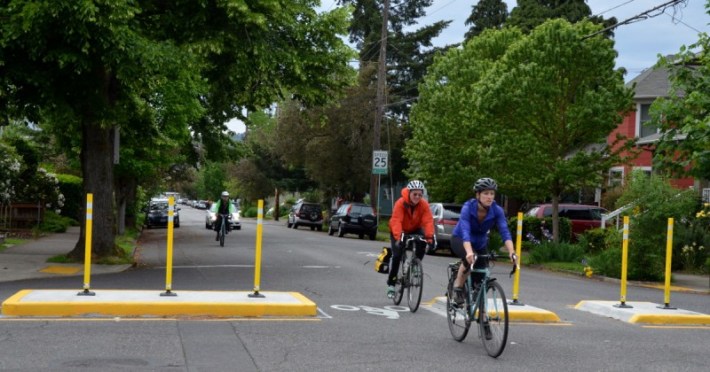Update 1/31/22, 1:15 PM: Here's a discussion of the Granville issue from urban planner and sustainable transportation advocate Omari Bektemba, who lives in the area.
Recently 40th Ward Alderman Andre Vasquez shared on the ward's Facebook page the results of the district's participatory budget election, in which a resident's proposal for bike lanes on Granville Avenue (6200 N.) was a winning item, among other items, including a pedestrian island at Berwyn and Ashland Avenues. Close to 2,200 constituents voted, and 243 of them supported adding bike lanes on Granville between Western Avenue (2400 W.) and Clark St. (1600 W.)
The proposed Granville bike lanes location (green line), with the locations of parks, schools, and Misericordia Home.
Disappointingly, however, Vasquez stated in the post that the Granville project "has been put on hold, pending further review," due to pushback from residents. Here's his full statement on that subject.
The Granville Bike Lane – In looking at the feedback sent by neighbors directly impacted, and also looking at the specific plans for the bike lanes, this option will be put on hold, pending further review.
In the plan proposed above by the Chicago Department of Transportation, the painted bike lanes provide guidelines for cyclist, but in doing so, create a larger traffic concern.
In the proposal, the painted lines also hinder simultaneous east and west vehicle travel, as drivers would have to move towards the center when cyclists are present, creating a larger traffic confusion when vehicles are traveling both east and west while cyclists are present.
Taking into account that the local elementary schools, Hayt and Stone, would create simultaneous east and west travel during pick up and drop off times, this proposal is being put on hold pending further review and community support.
Before we dive into the alderman's statement that "the painted bike lanes provide guidelines for cyclist, but in doing so, create a larger traffic concern,” I’m curious as to how it was determined who is “directly impacted” by the proposal. Is he referring to people who currently cycle that corridor, people who walk that corridor, people who live along Granville, a combination of the above, or something else? If we were taking traffic violence and the importance of getting more people on bikes seriously, we’d prioritize the needs of people who currently bicycle or would like to bike along this corridor over driver convenience and the attitude that “this is the way the road has always been.” I have reached out to Alderman Vasquez's office for clarification on who was defined as "directly impacted".
It's curious that Vasquez is saying CDOT's proposed a layout where “drivers would have to move towards the center when cyclists are present.” What difference does it make to motorists if bike lanes are striped, since the lanes would be located in the same part of the road where most people on bikes currently ride, a few feet from parked cars?
As for the alderman's statement that Hayt and Stone generate “simultaneous east and west travel during pick up and drop off times," the presence of elementary schools, two parks, and Misericordia Home (a center for people with intellectual and developmental disabilities), are all the more reason we should be creating safe cycling conditions for people of all ages and abilities along this corridor.

I’m reminded of a conversation I had with my alder in Rogers Park, Maria Hadden (49th) about the need to convert car parking spaces to bike lanes in some parts of the neighborhood in order to create safe cycling conditions. Hadden responded that many local parents in the area need cars in order to transport their children. Comments like this ignore how the status quo of prioritizing drivers creates a vicious cycle where younger children’s independent mobility is restricted because their parent believe that getting around without a car is impractical or unsafe, largely because of all the car traffic.
In light of the climate crisis and a spike in traffic crashes during the pandemic, it’s time for CDOT to stop prioritizing driver convenience and explicitly aim towards increasing bike mode share and decreasing vehicle miles travelled. More than half of all car trips in Chicago are less than three miles, and 22 percent of those trips are less than a mile. A transportation agency committed to the aforementioned goals would not look at Granville Avenue in isolation. It would also look at neighboring streets to consider how they aid or detract from comfortable cycling conditions. I’ve ridden this stretch of Granville many times and I’m always struck by the juxtaposition of its designation as a bike route and the heavy and speedy motor vehicle traffic it sees.
People are already biking along this corridor. It's likely part of why the proposal for bike lanes won the amount of votes it did. It is after all designated as a "bike route" but only in signage. There is no traffic calming like speed humps or frequent traffic circles. Given the road's width, perhaps chicanes or wider sidewalks could be an option if it were made a one-way street.
The shelving of this project reveals the lack of imagination and creativity at CDOT. Painted bike lanes are not the only way to create safe and comfortable cycling conditions, and they’re not even a terribly effective way to do that, considering how often drivers park or drive in them. I’m aware that the agency is currently not well-funded or empowered to create the type of sustainable and human-scale transportation we need. If it was, it would see the need for traffic volume reduction and other elements that make for sustainable, child-friendly, and accessible mobility.

I would love to see traffic diverters, treatments that prevent drivers from using side-streets as cut-through routes, while allowing cyclists to proceed on Granville off the major feeder streets: Sheridan, Broadway, Clark, Ridge/Ravenswood, and Western. It would go a long way towards making driving slightly inconvenient while reducing the number of unnecessary car trips. In my opinion, decreasing vehicle volumes is just as important as reducing vehicular speeds. Bicycle-friendly speed humps and raised crosswalks would also be needed as well. Car parking (that is, free storage of private property on the public way) would barely be impacted and those who choose or need to drive would still be able to access Granville, just less directly.
Cyclists on the other hand would have a comfortable and direct trip, and local residents would see less cut-through traffic. I imagine parents might feel more comfortable allowing their children to bike, scoot, or walk to the local schools, and those of all ages and abilities would feel more at ease traveling the corridor. As I contemplate this vision, I’m reminded of how much work there is to be done to achieve this on many of our streets. It won’t be easy but it’s possible.






